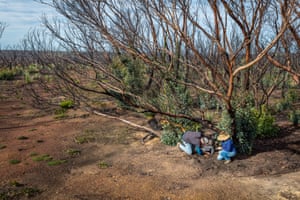Non-native predators and pests, forestry and farming mean our recovery is faltering. Here’s what we need to do
Australia’s “black summer” megafires were a severe blow to ecosystems already reeling from decades of adverse impacts. Feral predators and grazers, weeds and unsustainable land and water use have reduced the resilience of nature in Australia. So when the unprecedented fires came, they were able to push species to the brink.
Walking the fire grounds it was impossible to miss the immediate impacts: charred bodies of snakes lying among rocks, and dead wallabies floating in waterholes. But some astonishing survivors were also to be seen: small lizards that had waited it out in burrows, and birds that had fled to safety then returned. And with rain, the trees and grasses swiftly resprouted.
In an earlier Australia, these survivors would have kickstarted a process of ecosystem reassembly that would have eventually restored fire-affected areas to their original state. But today, because of great, human-wrought changes, that journey towards recovery is faltering. Climate-fuelled megafires have swept over a land filled with feral predators and pests – a land in which vital refuges have given way to forestry or farming.
The fires were fed by record-breaking temperatures and drought across southern and eastern Australia. Together these trends led to a step change. Prior to the summer of 2019-20, bushfires burned 2% or less of the nation’s temperate broadleaved forests. But over the black summer, 21% burned. That’s a tenfold increase in a single season.

The area that a bushfire burns has an important influence on post-fire recovery. Larger burned areas mean that creatures have farther to travel to recolonise the recovering forest. Koalas are particularly vulnerable in this regard. They live atop their own funeral pyres, so fires kill many.
Megafires threaten many species. Small mammals may survive the initial blaze, but they often succumb to predation or starvation in the aftermath of the fire, so succeeding generations must come from afar. Because reptiles don’t need to eat as often, they have better survival prospects. Even so, the shift from smaller fires to megafires can have a severe impact on them, because predation rates increase in the open habitats that dominate after the fire and vast areas of uniform-aged vegetation offer less varied resources.
Even before the fires, introduced predators such as foxes and cats were having a severe impact on native species. But the fires have supercharged that impact. Cats can travel for tens of kilometres to feast at the fire margin, where the survivors are both concentrated and vulnerable. This predation destroys the populations that would otherwise recolonise the burned lands. Unless numbers of foxes and cats are controlled, they can drive species into extinction.

The NSW National Parks and Wildlife Service is making great efforts to control the number of feral animals in the wake of the fires. Baiting to control foxes has increased fivefold, with special emphasis on the areas burned over the summer. In the largest feral animal control programme ever delivered in NSW, 60,000 fox baits will be laid over 2020, giving bandicoots, potoroos and other natives a chance of survival. And by June, more than 8,000 feral herbivores – mainly goats, deer and pigs – had been removed from national parks because their grazing can severely impact post-fire recovery. These efforts will benefit wildlife for many years.
Other threats to biodiversity have become evident in the wake of the bushfires. The flooding rains that doused the fires in February did more damage to some endangered species than the fires themselves. Ponds used for breeding by critically endangered frogs such as the northern corroboree frog were destroyed by infilling with ash. And ash, charcoal and toxins flooded waterways, killing fish and other aquatic life. Even the marine environment was impacted, with toxic runoff damaging nearshore reefs and other communities around Sydney.

In the wake of our black summer, those who care for the nation’s biodiversity have done a creditable job. But the ongoing decline of many species, including the koala, demonstrates that we need to do much more. In addition to reducing the greenhouse gas pollution that is driving the megafires, we need to rethink our emergency response to endangered wildlife. There is an urgent need to protect critical habitats, such as wetlands and unburned old-growth forests. And we may need to translocate koalas and other endangered species so that they can expand their distributions, and thus become more resilient, in the face of fires.
There is also an urgent need to increase our knowledge. As I read about the people working to save species from extinction after the fires, I was struck by how few people knew where the last survivors of various species were to be found. In some cases, a single doctoral student was the only person able to locate them. At this time of accelerating threat to Australia’s biodiversity, we need to beef up our knowledge base, and that means greater funding to universities and the government agencies that are our first line of defence for endangered species.
• Professor Tim Flannery is an author and scientist and one of Australia’s leading voices on the climate crisis
Find more age of extinction coverage here, and follow biodiversity reporters Phoebe Weston and Patrick Greenfield on Twitter for all the latest news and features
.png)

No comments:
Post a Comment